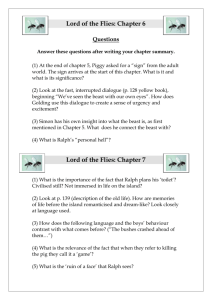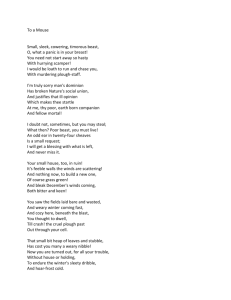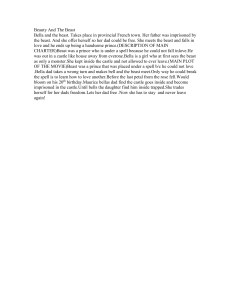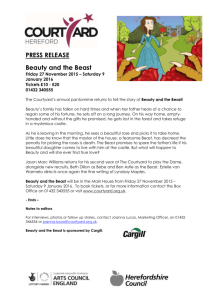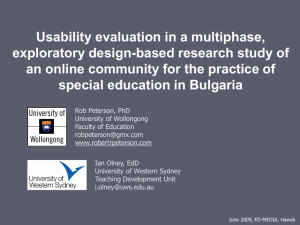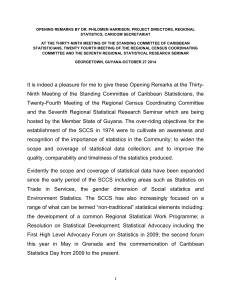A Learning Theory and ID for 21st C Learners - The
advertisement
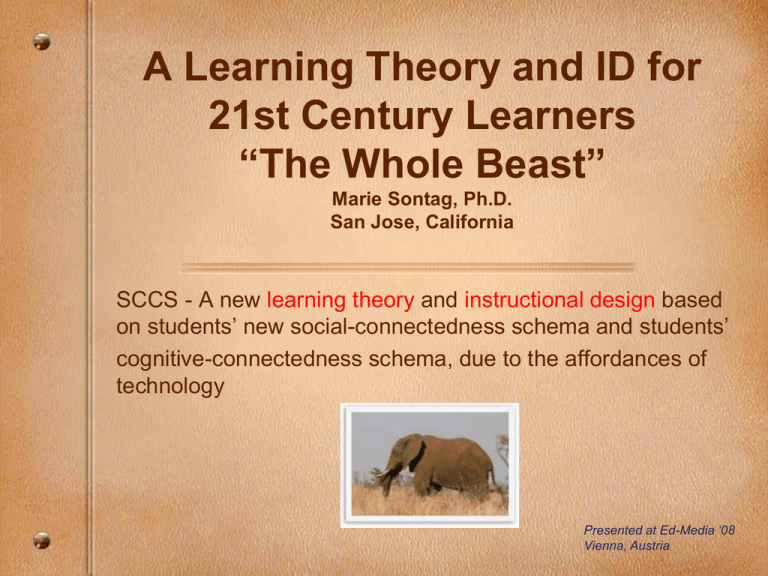
A Learning Theory and ID for 21st Century Learners “The Whole Beast” Marie Sontag, Ph.D. San Jose, California SCCS - A new learning theory and instructional design based on students’ new social-connectedness schema and students’ cognitive-connectedness schema, due to the affordances of technology Presented at Ed-Media ‘08 Vienna, Austria Premise: The affordances of today’s technologies have significantly effected changes in the way students connect to others, and in the way they connect to information. Objective: This PowerPoint presents the six constructs of a new learning theory and instructional design model (SCCS), based on changes in students’ schemata. New Learning Theory and ID Model Social and Cognitive-Connectedness Schema SCCS - or “The Whole Beast” Ed-Media ‘08 The Blind Men and the Elephant by John Godfrey Saxe 1 http://www.wordinfo.info/words/index/info/view_unit/1/?letter=B&spage=3 Schaller and Allison-Bunnel: We are in a “pre-paradigmatic phase of learning style research. The blind researchers have each described a different part of the elephant, but have not yet synthesized their findings into a picture of the whole beast”. 2 Ed-Media ‘08 Different Parts of the Beast Various learning theories focus on various aspects of learning. Behaviorism: Behaviorism focuses on learning as a process of connections between a stimulus and a response. Ed-Media ‘08 Different Parts of the Beast Cognitivism: Cognitivism is concerned with internal knowledge. Cognitivism views knowledge as having identifiable parts that can be classified based on the nature, content, and goals of the learner. 3 Ed-Media ‘08 Different Parts of the Beast Constructivism: In constructivism, learners build an internal representation of knowledge, a personal interpretation of their experiences. 4 Ed-Media ‘08 Different Parts of the Beast Situativity: In situativity, knowledge and meaning are viewed as the result of participation in social activities, often referred to as a community of practice. 5 Ed-Media ‘08 The Whole Beast? (Siemens, 2005) “The underlying conditions have altered so significantly that further modification is no longer sensible. An entirely new approach is needed.” 6 Siemens holds that students’ schemata has so dramatically changed, due to the affordances of technology, that we must lay aside previous learning theories and turn to something entirely new. In connectivism, knowledge is viewed as something that continues to grow and evolve. Knowledge is a network-forming process. Learners are viewed as knowledge conduits rather than as containers. Ed-Media ‘08 The Whole Beast? Connectivism better reflects the idea of students’ social and cognitiveconnectedness schemata (SCCS), but as an emergent theory, connectivism has not yet conducted research to help validate it, or developed an ID model to help instructors implement it. Ed-Media ‘08 Different Parts of the Beast Each theory does a good job of describing the part of learning that it is looking at, but, as suggested by Schaller and Allison-Bunnel, we need to synthesize our findings into a picture of the whole beast. Ed-Media ‘08 The Whole Beast SCCS synthesizes the learning theories and ID models that best match the schemata of todays’ students. Ed-Media ‘08 SCCS Theory and ID Model Three CognitiveConnectedness Schema Constructs Three SocialConnectedness Schema Constructs 1. Navigation Literacy 1. Link 2. Discovery-Based Learning 2. Lurk 3. Lunge 3. Reasoned Judgments Based on a Plethora of Resources Ed-Media ‘08 In the SCCS ID model, the SCCS constructs are embedded within the context of learning theories and ID models that match students’ schemata. The SCCS ID model also advocates the insertion of game design elements. For more detail, see the dissertation at http://tinyurl.com/2 utsrj SCCS embedded within these four ID Models: 1. Wiggins & McTighe’s Enduring Understanding Model 2. Mayer’s SOI Model 3. Van Merrienboer, Kirschner, & Kester’s 4C/ID Model 4. Elements of game design Ed-Media ‘08 Bibliography 1. Saxe, John Godfrey, (1816-1887). The Blind Men and the Elephant, http://www.wordinfo.info/words/index/info/view_unit/1/?letter=B&spage=3 2. Schaller, D., & Allison-Bunnell, S. (2003). Practicing what we teach: How learning theory can guide development of online educational activities. Museums and the Web 2003: Selected Papers from an International Conference. Charlotte, NC. Retrieved April 21, 2005 from www. archimuse.com/mw2003/papers/ schaller/schaller.html 3. Bednar, A., D. Cunningham, T. Duffy, and J. Perry. 1992. Theory in practice: How do we link? In Constructivism and the technology of instruction: A conversation, eds. T. Duffy and D. Jonassen, 17-35. Hillsdale, NJ: Erlbaum. 4. Bednar, A., D. Cunningham, T. Duffy, and J. Perry. 1992. Theory in practice: How do we link? In Constructivism and the technology of instruction: A conversation, eds. T. Duffy and D. Jonassen, 17-35. Hillsdale, NJ: Erlbaum. 5. Barab, S., and T. Duffy. 2000. From practice fields to communities of practice. In Theoretical foundations of learning environments ed. D. Jonassen and S. Land, 2555. Mahwah, NJ: Erlbaum. Ed-Media ‘08 Bibliography, Continued 6. Siemens, G. 2005. Connectivism: A learning theory for the digital age. International Journal of Instructional Technology & Distance Learning, 2 (1) http://www.itdl.org/Journal/Jan_05/article01.htm (accessed March 30, 2008). Archived at http://www.webcitation.org/5WiaG1f5h. 7. Brown, J., Collins, A., & Duguid, P. (1989). Situated learning and the culture of learning. Paragraph 11, Education Researcher, 18(1), 32-42. Retrieved April 29, 2005, from http://www.exploratorium.edu/ifi/resources/museumeducation/situated.html 8. Sontag, M. (2007). Dissertation link: http://tinyurl.com/2utsrj or http://web.mac.com/mariesontag1/SCCS_Dissertation/Dissertation__M._Sontag,_2007.html Ed-Media ‘08
